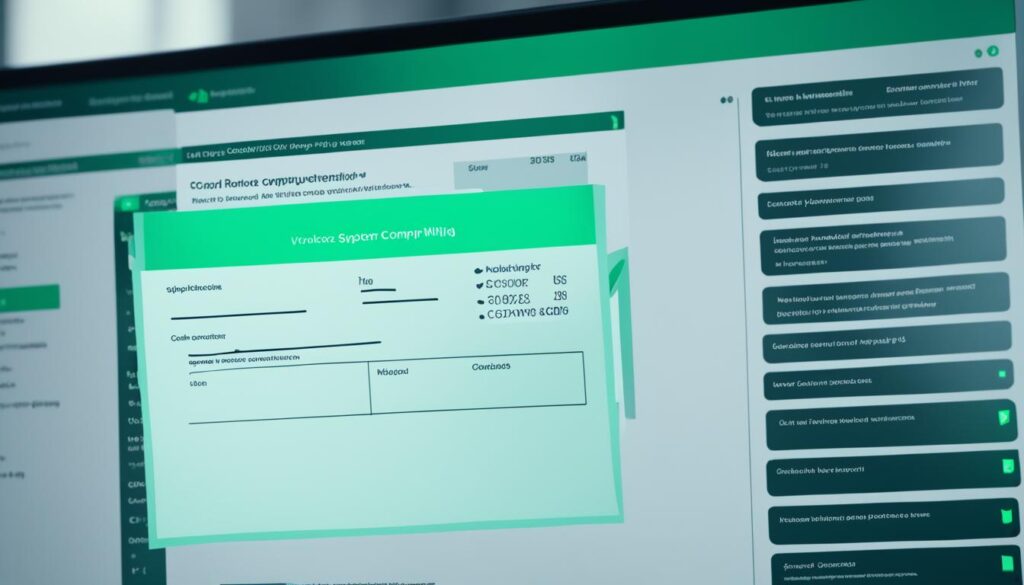Did you know that 35% of internet users attribute a great deal of their online security to the presence of a verified digital signature? It’s a statistic that underscores the importance of code signing, a security staple that shields countless users from the menace of malicious software. But the impact of code signing goes beyond safety; it’s a herald for trust, authenticity, and professionalism. Underscoring this narrative, let’s dive into some compelling success stories of code signing and explore the tangible benefits realized by real companies such as Codemagic users like UDO Games, Invoice Ninja, and Very Good Ventures.
The thrust of these code signing success cases isn’t merely about staving off cyber threats but also about easing the software development process. Validation, automation, and streamlining deployment processes constitute the bedrock of these stories, revealing significant metrics of success and strategic implementation approaches that pave the way for efficient delivery of premium digital products.
Key Takeaways
- Code signing is essential for establishing user trust and preventing software tampering.
- Improvements in development efficiency are a direct result of streamlined code signing processes.
- Real-world cases from Codemagic users demonstrate the significant time and effort saved in development cycles.
- Automated code signing can drastically reduce deployment timelines, making a case for its implementation in CI/CD.
- The companies featured not only enjoy improved security but also display how proper code signing contributes to successful project management.
- These success stories serve as practical examples for others considering the implementation of code signing in their workflow.
Embracing Code Signing: A Game Changer for UDO Games
The interactive entertainment industry moves at a blistering pace, and for developers like UDO Games, staying ahead of the curve is not just an aspiration, but a necessity for survival. In their quest for innovation and efficiency, UDO Games incorporated a pivotal strategy into their development lifecycle: code signing. This tactical move, enabled by Codemagic, bestowed them with substantial competitive advantages in their Unity game creation endeavors.

Accelerated Build Processes with Codemagic
For UDO Games, time is as valuable as their immersive game adventures. Before integrating Codemagic into their deployment protocols, the studio faced lengthy and unpredictable build processes. Real-world code signing examples have repeatedly shown the ability to tighten the reigns on time management, which UDO Games has attested through their adoption of Codemagic’s continuous integration and delivery services. Implementing a streamlined code signing workflow significantly expedited the journey from raw code to fully developed game, saving precious hours and resources. The results were clear — quicker turnarounds on builds meant more rapid iterations, more testing, and, ultimately, a higher quality gaming experience for their audience.
Enhanced Development Efficiency in Unity Game Creation
UDO Games leveraged the power of Unity, a platform known for its agility and flexibility, to further refine their development process. The collaboration with Codemagic introduced an additional layer of efficiency, encapsulating the pinnacle of code signing benefits. It established a development pipeline that was not only faster but also consistent and reliable. By embracing code signing, UDO Games could automatically ensure the integrity and origin of their game builds, instilling trust among its players. This assurance is non-negotiable in a digital landscape where security is paramount.
The process redesign, with code signing at the forefront, has been nothing short of transformative. UDO Games’ experiences serve as an instructional blueprint for other studios seeking to overhaul their build systems. The enhanced efficiency and accelerated build processes are powerful endorsements of the tangible benefits of code signing within real-world applications. For UDO Games and their peers, code signing has proven to be more than just a best practice; it has emerged as a game-changer in creating trust and delivering entertainment expediently and securely.
Invoice Ninja: Achieving Consistency in App Builds Through Code Signing
In the realm of modern software development, the importance of code signing validation cannot be overstated. Invoice Ninja, an innovative invoicing platform for freelancers and businesses, is a prime example of how code signing is crucial for consistent app builds. By implementing code signing implementation strategies through the integration with Codemagic, Invoice Ninja significantly improved the reliability of their products.
Before turning to CI/CD solutions, the team behind Invoice Ninja was familiar with the frustration of inconsistent outputs that compromised build reliability. The variation in builds not only affected internal testing but also impacted client trust. It was clear that a systematic change was necessary—this is where the solid framework of code signing stepped in to enhance their build ecosystem.

The transition to a CI/CD infrastructure fortified with code signing was more than a technical upgrade; it represented a strategic move towards dependable, secure app creation. By doing so, Invoice Ninja ensured that every build released is uniform, verifiable, and trusted by end-users, which is integral in today’s cyber-security conscious market.
With the adoption of such robust code signing protocols, the discrepancies that once plagued their deployment pipeline diminished, ushering in a new era of development peace of mind.
- Automation of build processes
- Smoother workflows and team collaboration
- Improved security and integrity of applications
By sharing the journey of Invoice Ninja, we shed light on how critical code signing is—not just as a security measure but as a foundational component of a streamlined development workflow that can accommodate rigorous demands whilst maintaining high-quality standards.
| Aspect | Before Code Signing | After Code Signing |
|---|---|---|
| Build Consistency | Inconsistent | Consistent |
| Development Flow | Interrupted | Streamlined |
| Security | Basic | Enhanced |
| User Trust | Variable | Strengthened |
As illustrated, the strategic application of code signing has profound implications on software delivery excellence. Invoice Ninja’s success in implementing these solutions underscores not just the necessity but the substantial benefits that code signing protocols bring to the table, echoing its critical role in current and future app development projects.
The Transformative Impact of Code Signing on Very Good Ventures’ Deployments
In the competitive realm of software development, Very Good Ventures achieved remarkable agility and security by incorporating code signing best practices into their release management workflow with Codemagic. Let’s delve into the procedure they followed, and examine code signing success metrics that signify their triumphant strategy in managing client projects.
Streamlining Client Services with Code Signing Best Practices
For Very Good Ventures, the adoption of code signing was a critical pivot point that led to improved operational efficiency. Prioritizing this security process, Codemagic became the linchpin in their deployment process, providing a clear structure for managing certifications and keys which, in turn, supported a vast and varied client base.
Their approach emphasizing code signing best practices included:
- Automated signing for multiple platforms, ensuring consistent and secure releases.
- Rigorous checks to maintain code integrity from development to deployment.
- Integrating code signing into their Continuous Integration/Continuous Deployment (CI/CD) workflow for seamless automation.
By fine-tuning these elements, Very Good Ventures could dispatch services reliably and promptly, contributing to higher client satisfaction and robust reputation management.
Codemagic’s Role in Successful App Launches
Codemagic’s platform played an instrumental role in shaping the route to success for Very Good Ventures’ app launches. The powerful capabilities of Codemagic helped the firm set and achieve quantitative code signing success metrics, including:
| Metric | Before Code Signing | After Implementing Best Practices |
|---|---|---|
| Deployment Speed | Variable | Consistent & Accelerated |
| Security Incidents | Occasional Breaches | Significant Reduction |
| Client Onboarding Time | Lengthy | Optimized & Reduced |
| Release Confidence | Unpredictable | High Assurance |
These success metrics underscore the profound difference that code signing can make when properly incorporated into a company’s deployment strategy, particularly through a powerful tool like Codemagic.
Embracing a culture of security and efficiency through code signing best practices is more than just a strategic move—it is essential for safeguarding the prestige and reliability of both the company and its clients in an era where digital trustworthiness is paramount.
Criton’s 95% Time Reduction in Deployment with Code Signing Validation
In the fast-paced world of app development, Criton has achieved a landmark success by implementing code signing validation, leading to a staggering 95% reduction in their deployment schedule. This strategic move has set a new benchmark in efficiency and security, propelling Criton to the forefront as a code signing success case.
The Importance of Code Signing in White Label Apps
Primarily known for their white label application services, Criton’s decision to embrace code signing was pivotal. By integrating these practices, Criton ensured that their clients’ branded apps were sealed against tampering and intellectual property breaches, thereby upholding trust and integrity in a competitive marketplace.
Automating the Build Pipeline for Efficient App Releases
The drive towards automation within Criton’s build pipeline has monumentally enhanced their release cycle. Linking automated code signing into their CI/CD systems, they achieved remarkable efficiency gains, streamlining the time-to-market for their diverse suite of white label solutions.

| Pre-Code Signing Scenario | Post-Code Signing Outcomes |
|---|---|
| Time-consuming manual signing processes | Swift automated code signing |
| Frequent security vulnerabilities | Robust app security through stringent validation |
| Erratic deployment schedules | Consistent and predictable app releases |
| Diluted brand integrity for clients | Maintained brand reputation through trusted app security |
How Code Signing Catalyzed Schneider Electric’s Transition to Codemagic
The global landscape of software development is replete with real world code signing examples where the adoption of comprehensive CI/CD tools have streamlined development processes. An exemplary case is that of Schneider Electric, an enterprise renowned for innovation in energy management and automation, and their strategic shift to utilize Codemagic’s robust code signing benefits.
In response to the evolving demands of software security and build efficiency, Schneider Electric recognized the imperatives of an advanced code signing mechanism. This realization was the catalyst for their transition from Nevercode to Codemagic, signifying a major advancement in their software deployment rigor. The transition marks a milestone, underscoring the prowess of code signing as an enabler of secure and efficient software builds in a commercially dynamic environment.
The move to Codemagic was driven by the platform’s strong support for code signing, ensuring that Schneider Electric’s applications were authenticated and unaltered from development to deployment. By consolidating the code signing process within their CI/CD pipeline, Schneider Electric not only enhanced their security posture but also achieved significant time and resource optimizations. The following table compares the pre and post transition scenarios at Schneider Electric, highlighting the impact of code signing within their CI/CD process.
| Aspect | Pre-Codemagic Era | Post-Codemagic Transition |
|---|---|---|
| Build Security | Basic Signature Verifications | Advanced Code Signing Protocols |
| Process Efficiency | Manual Interventions | Automated Workflows |
| Deployment Speed | Variable, often delayed | Consistent and timely |
| Developer Experience | Segments lacking integration | Seamless and integrated |
In essence, the code signing capabilities of Codemagic endowed Schneider Electric with not just an elevated layer of confidence in their software integrity, but also crystallized the role of automation in accelerating deployment cycles. It is these code signing benefits that serve as a beacon to other enterprises looking to enhance their development infrastructure.
At the heart of this shift is the real-world efficacies offered by a comprehensive code signing strategy – a testimony to the transformative power of aligning the right tools with organizational objectives in the software domain. Schneider Electric’s journey vividly illustrates the beneficial resonance of code signing within modern CI/CD paradigms.

Code Signing Best Practices for Optimized Testing and Build Environments
To maintain integrity and trust in software applications, especially on macOS systems, developers must adhere to code signing best practices. These practices not only preserve security but also streamline the development cycle by optimizing testing and build environments. Leveraging automation for code signing is becoming a pivotal tactic to minimize efforts and mitigate risks in software release pipelines.
Business Automation and the Importance of Code Signing for macOS
macOS stands out as an operating system that places a high emphasis on security, making code signing validation a non-negotiable step in the development process. The automation of these tasks is crucial for business efficiency. By integrating code signing into automated workflows, developers ensure both compliance with macOS requirements and maintain a rapid pace of continuous delivery.

Testmagic CI/CD and the Advantages of Automated Signing
Testmagic CI/CD exemplifies a successful implementation of automated code signing. By incorporating code signing into the CI/CD pipeline, Testmagic has demonstrated the compelling advantages of such automation, including the reduction of manual errors and a faster turnaround time for app development cycles. This approach directly translates to heightened security measures and an accelerated path to market for software solutions.
Ultimately, the importance of code signing validation cannot be overstressed. As the digital landscape continues to evolve, the need for secure and efficient code signing implementation strategies takes center stage to safeguard the software delivery process against malicious tampering and to assure the end-users of the application’s integrity.
Success Stories of Code Signing: Scaling Development with Codemagic CI/CD
The code signing benefits realized by companies like ClearPoint and Sidis by Nemobile are more than just enhancements in security—they’re key ingredients in the recipe for development success. By integrating Codemagic CI/CD into their systems, these firms highlight the impact of code signing on scalability, revealing a significant reduction in development time and costs.
As an illustration, let’s consider the measurable impacts of code signing, a critical component in understanding code signing success metrics. When scalability and efficiency are paramount, Codemagic CI/CD shines as the automation champion. The following table showcases the critical data points that articulate the advantages reaped by companies deploying Codemagic’s solutions:
| Company | Time Saved | Cost Savings | Process Improvements |
|---|---|---|---|
| ClearPoint | 30% reduction | 20% decrease in overhead | Automated workflows |
| Sidis by Nemobile | 40% reduction | 25% decrease in deployment costs | Enhanced release frequency |
These figures are not just statistics; they reflect real-world enhancements that drive businesses forward. Code signing has effectively become a cornerstone for development vitality, ensuring that scalability is not just an ambition but a tangible outcome for those adopting Codemagic CI/CD.
Code Signing Implementation Strategies for Effective Development Workflows
In today’s fast-paced digital market, the significance of secure and efficient app deployment cannot be overstated. Industry leaders have consistently illustrated that adopting a robust code signing protocol can greatly enhance the development workflow, assuring both the developer and the end-user of the software’s integrity. Two such cases that are exemplary in demonstrating the merits of diligent code signing implementation strategies and their positive repercussions are those of iTomic and Listo.
How Codemagic’s CI/CD Solutions Improve App Store Deployments
The integration of CI/CD solutions like Codemagic into the deployment process has dramatically transformed how apps are delivered to the App Store. As a testament to the code signing success cases, companies leveraging Codemagic’s expertise have reported a seamless transition from development to production, crediting code signing as the bridge that has eliminated many hurdles associated with app distribution.
Insights from iTomic and Listo on Time Savings in App Releases
Both iTomic and Listo have shared their successful experiences with code signing, singling out the expedited timeframes achieved when releasing their apps. By integrating code signing into their CI/CD pipelines, these organizations have been able to navigate the oft-daunting approval process with greater ease and confidence. This strategic implementation has not only fortified their workflow against potential security pitfalls but also provided a quickened path to market.
Key takeaways: Introducing Codemagic’s services has led to enhanced proficiency and security during code signing, positively impacting app store deployment and time management in app releases. The cumulative knowledge shared by iTomic and Listo affirms the critical role of code signing as a cornerstone of a successful deployment strategy.
Navigating the Evolution of Code Signing: Past, Present, and Future
Code signing has undergone a remarkable transformation, emerging as a cornerstone of software security. Initially a straightforward step in the deployment process for developers, recent years have introduced a level of complexity that underscores the importance of code signing validation. The heightened security measures in platforms such as macOS have shifted from a recommended practice to an absolute necessity, with developers bearing the critical responsibility to secure their applications against tampering.
With the introduction of Apple’s notarization requirements, in addition to code signing, it’s clear that the landscape is evolving. Notarization acts as an additional layer of validation that the software has not been altered following the code signing process, providing users with further reassurance on the integrity of their downloaded apps. This change propels a more complicated procedure for developers, requiring meticulous attention to ensure their applications meet the stringent security standards before reaching users.
The adoption of tools that specialize in automating the code signing process has significantly benefited developers, mitigating the administrative burden and allowing them to dedicate more time and resources to innovation and development. This automation has become a lifeline for many, ensuring their apps remain credible and trusted in the eyes of users worldwide.
As we look toward the future, the trajectory of code signing is poised to become even more integral as security continues to be a paramount concern. Driven by the relentless advancement of cyber threats, developers and companies must remain vigilant, adopting the newest practices in code signing validation. It is not just about protecting the end-user; it is about safeguarding the reputation and the very essence of the digital goods we rely on every day.
Ultimately, the importance of code signing validation persists as a critical topic, shaping the framework for a trusted digital space. As the narrative of code signing continues to unfold, its role in the ongoing quest for robust application security becomes all the more pronounced, anchoring the sanctity of the development lifecycle.
Conclusion
In evaluating the journey through code signing’s landscape, one cannot help but acknowledge the profound impact it has on modern software delivery. This is clearly evidenced by the code signing success metrics that have been redefined by organizations who’ve embraced these measures. Deliverables have seen remarkable improvements in stability and expedient circulation, attesting to the methodology’s vital role in software security and trust.
Reflecting on the Measurable Benefits of Code Signing Success Metrics
The practical benefits reaped from the adoption of code signing practices extend far beyond the realms of cybersecurity. They include measurable gains such as enhanced build dependability, a noticeable contraction in production cycles, and a more fluid update rollout process. These benefits not only bolster security but also drive efficiency and competitiveness in a fast-paced industry.
Why Real World Code Signing Examples Serve as a Beacon for Emerging Developers
Moreover, authentic case studies – real world code signing examples provided by industry pioneers such as UDO Games, Invoice Ninja, and Very Good Ventures – serve as invaluable resources and sources of inspiration for burgeoning developers. Their experiences underscore the clear advantages of incorporating code signing and streamlined CI/CD processes. Adopting these practices is not just about surmounting today’s technological challenges, but about paving the way for innovation, fostering a stronger software development culture poised for future triumphs.
FAQ
What tangible benefits did UDO Games realize through code signing?
UDO Games experienced accelerated build processes, enhanced development efficiency, and significant improvements in their Unity game creation workflows as a result of implementing code signing with Codemagic.
How did code signing impact the app build consistency for Invoice Ninja?
Code signing validation and implementation strategies with Codemagic enabled Invoice Ninja to overcome previous inconsistencies and achieve a reliable and consistent build output for their software applications.
Can you describe the transformative impact of code signing on Very Good Ventures?
Very Good Ventures benefited from streamlined client services, an increase in deployment automation, and a successful track record of app launches, which can all be attributed to their adoption of code signing best practices with Codemagic.
How was Criton able to achieve a 95% time reduction in their deployment timeline?
By automating their build pipeline with Codemagic and implementing code signing validation processes, Criton greatly reduced their deployment timeline, especially for their white label apps.
What was the catalyst for Schneider Electric’s transition to Codemagic?
The need to support a robust code signing procedure in a more streamlined and secure build process was the key driver for Schneider Electric’s transition to the Codemagic platform.
What are the best practices for code signing in testing and build environments?
Best practices include embracing automation, using appropriate tools like Testmagic and Codemagic for CI/CD, and ensuring the security and integrity of code signing certificates, especially for platforms like macOS where the security demands are high.
How does code signing contribute to scaling development efforts with Codemagic CI/CD?
Code signing with Codemagic CI/CD introduces efficiency by saving development time, reducing errors, and ensuring secure releases, thus providing a scalable solution for development teams.
What are some code signing implementation strategies for improving App Store deployments?
Strategies include integrating code signing into the CI/CD pipeline with tools like Codemagic, securing and managing signing certificates, and automating the signing process to streamline app submissions to the App Store.
How has the process of code signing evolved, particularly on macOS?
The code signing process has become more complex with additional requirements such as notarization. Developers now need to ensure that their macOS apps are both signed and notarized to meet Apple’s security standards and provide a seamless user experience.
Why are real-world code signing examples important for emerging developers?
Real-world examples provide insights and practical knowledge on how code signing and CI/CD best practices can lead to enhanced security, faster deployment, and ultimately successful product launches, serving as valuable guidance for novice developers.


